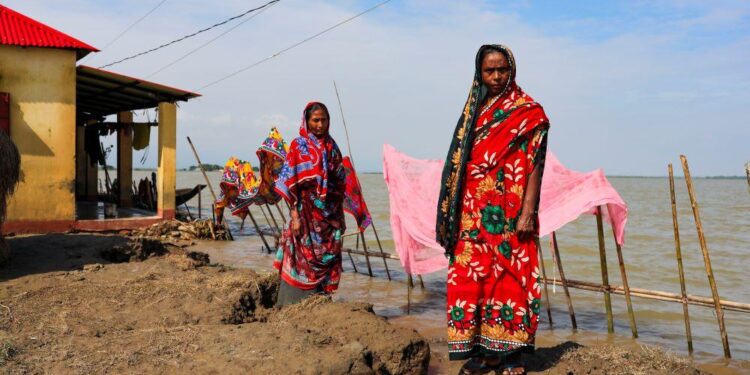Gujarat’s Crackdown on Undocumented Migrants: A Closer Look at Recent Detentions
In a decisive move to curb illegal immigration, Gujarat authorities have apprehended more than 1,000 undocumented migrants from Bangladesh in the bustling cities of Surat and Ahmedabad. This extensive enforcement action, conducted over the past week, underscores escalating concerns about unauthorized cross-border movement within India. Supported by intelligence agencies, local law enforcement executed targeted raids in neighborhoods known for harboring undocumented populations. The majority of those detained are individuals pursuing improved economic prospects but now face potential legal proceedings and deportation as the state intensifies efforts to manage migration while safeguarding national security.
Rising Illegal Migration in Gujarat’s Metropolitan Areas: Insights into Recent Arrests
The surge in detentions across Gujarat’s urban hubs reflects a growing influx of undocumented migrants primarily originating from Bangladesh. Cities like Surat and Ahmedabad have witnessed increased scrutiny amid reports of expanding migrant communities residing predominantly in informal settlements. This trend raises critical questions regarding India’s border control mechanisms and immigration frameworks as local authorities ramp up operations to address these challenges.
Many detainees are young men who enter India through unofficial channels, complicating enforcement efforts aimed at stemming irregular migration flows. These migrants often take up low-paying jobs within informal sectors—an economic dynamic that adds layers of complexity to regional labor markets.
- Pressure on Public Infrastructure: Heightened demand for affordable housing, healthcare services, and social welfare programs strains municipal resources.
- Security Risks: Concerns about potential involvement with illicit networks or unregulated activities persist among officials.
- Cultural Friction: Growing xenophobic sentiments contribute to social fragmentation within affected communities.
| City | Migrants Detained | Main Nationality |
|---|---|---|
| Surat | 600+ | Bangladesh |
| Ahmedabad | 400+ | Bangladesh |
The Humanitarian Dimension and Legal Challenges Surrounding Migrant Detentions in India
The mass detention operation has ignited widespread debate over its humanitarian consequences. Many detainees serve as primary earners for their families back home; their sudden removal disrupts household stability and livelihoods across borders. Reports highlight substandard conditions within detention centers—often overcrowded with inadequate access to basic amenities—raising serious human rights concerns about treatment standards for vulnerable populations seeking refuge or better living conditions.
This situation also presents intricate legal dilemmas under both domestic legislation and international obligations. While Indian authorities emphasize sovereignty over immigration control, they must simultaneously comply with commitments under global human rights conventions that protect asylum seekers from arbitrary detention and guarantee access to fair legal processes.
- The right to apply for asylum without fear of persecution;
- Safeguards against indefinite or unjustified confinement;
- Provision of adequate legal representation during proceedings;
- Ensuring humane living conditions throughout detention periods;
Civil society groups argue that current practices frequently fall short of these standards, marginalizing already vulnerable groups rather than offering protection or integration pathways. Consequently, there is mounting advocacy urging reforms that balance national security priorities with compassion-driven policies respecting migrant dignity.
Tackling Illegal Migration: Strategic Approaches & Policy Suggestions for Sustainable Solutions
The recent large-scale detainment highlights an urgent need for comprehensive strategies addressing illegal migration’s root causes alongside immediate enforcement actions.Pioneering enhanced border management technologies—including drones surveillance systems—and increasing patrol frequency along sensitive corridors can significantly reduce unauthorized crossings.
A collaborative regional framework involving neighboring countries such as Bangladesh could facilitate intelligence sharing while jointly addressing socio-economic drivers pushing people toward irregular migration routes.This cooperation might include joint task forces focused on dismantling trafficking networks exploiting vulnerable populations seeking work abroad.
A multi-pronged policy agenda should also encompass:
- Development initiatives aimed at creating sustainable employment opportunities domestically within Bangladesh—to alleviate poverty-induced migration pressures;
- Streamlining formal visa channels enabling safe labor mobility between countries;< li >Partnerships with NGOs delivering vocational training programs targeting high-risk demographics prone to irregular movement;
Additionally,a regularization scheme offering pathways toward legal residency status could integrate existing undocumented residents into society more effectively while safeguarding their fundamental rights—a step proven effective in other nations facing similar challenges such as Malaysia’s Temporary Employment Program reforms implemented since 2023.* (Source: International Labour Organization).
A Final Perspective: Navigating the Complexities Surrounding Migration Management in Gujarat & Beyond
The recent crackdown involving over a thousand Bangladeshi nationals detained across Surat and Ahmedabad epitomizes India’s ongoing struggle balancing stringent border controls against humanitarian considerations amid rising migratory pressures throughout South Asia.
This episode accentuates the necessity not only for robust law enforcement but also forward-looking policies fostering international collaboration alongside socio-economic development initiatives targeting root causes driving displacement.
As this narrative unfolds further attention will be required concerning human rights adherence coupled with pragmatic solutions promoting regional stability.
Ultimately,the evolving discourse around migration demands nuanced responses prioritizing safety,reform,and justice equally among all stakeholders involved—from governments down through affected communities themselves.















